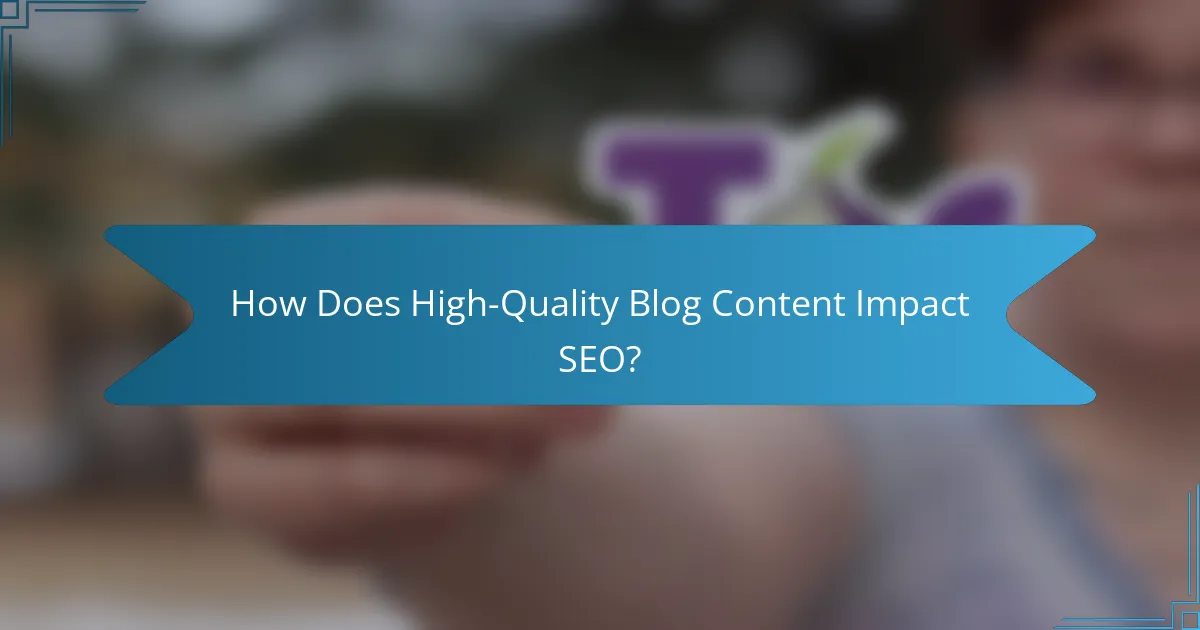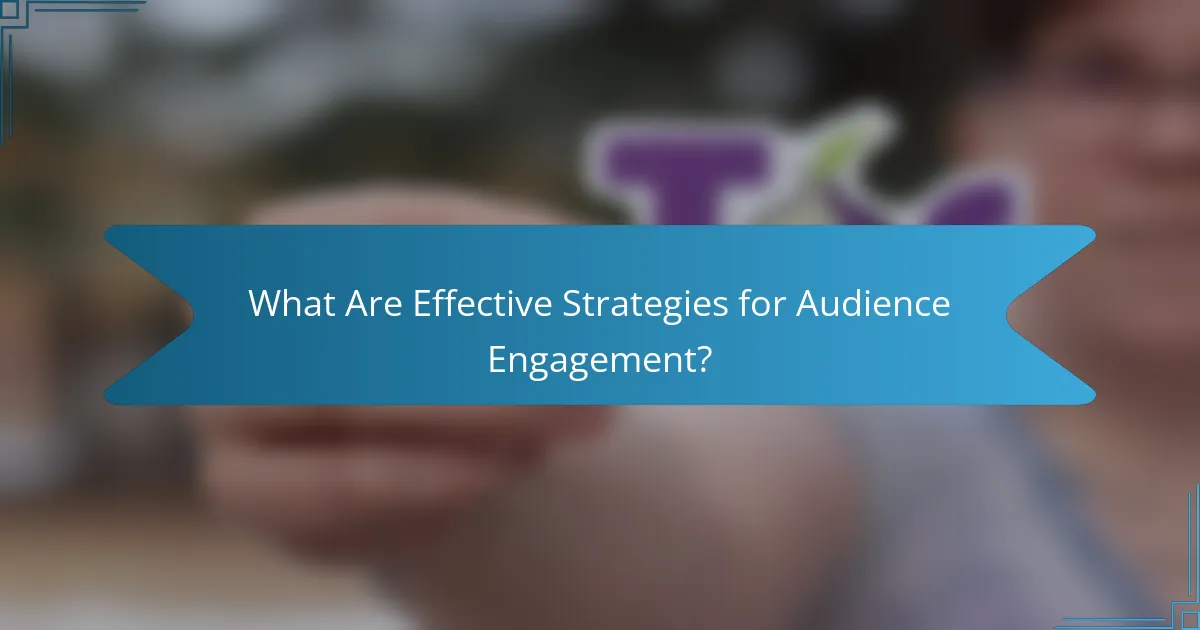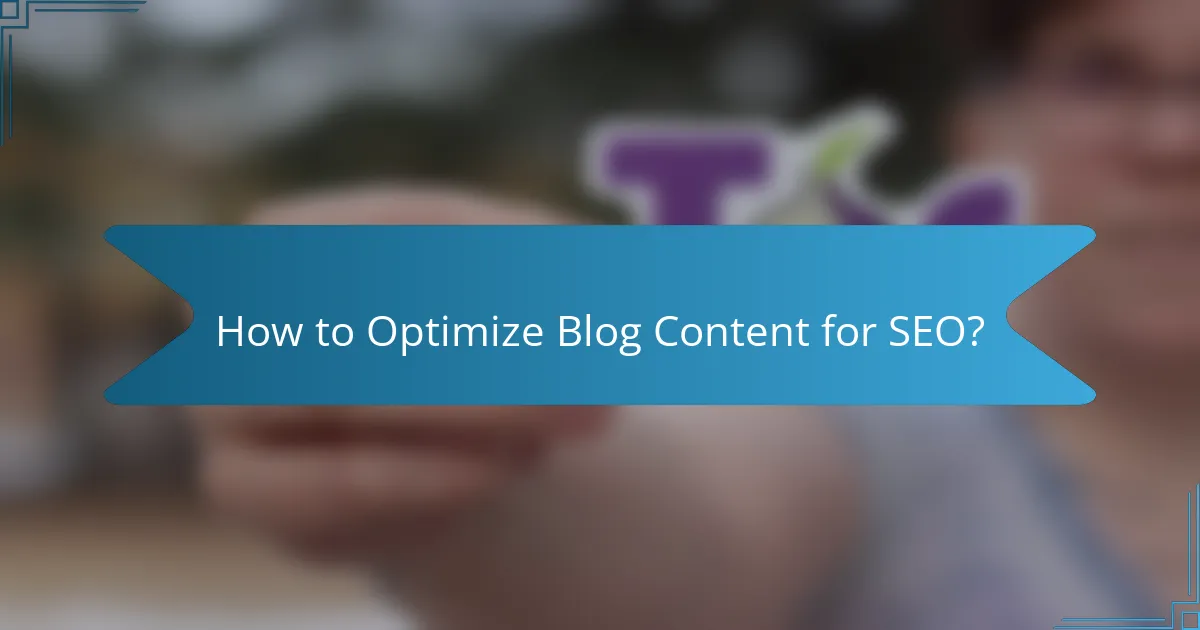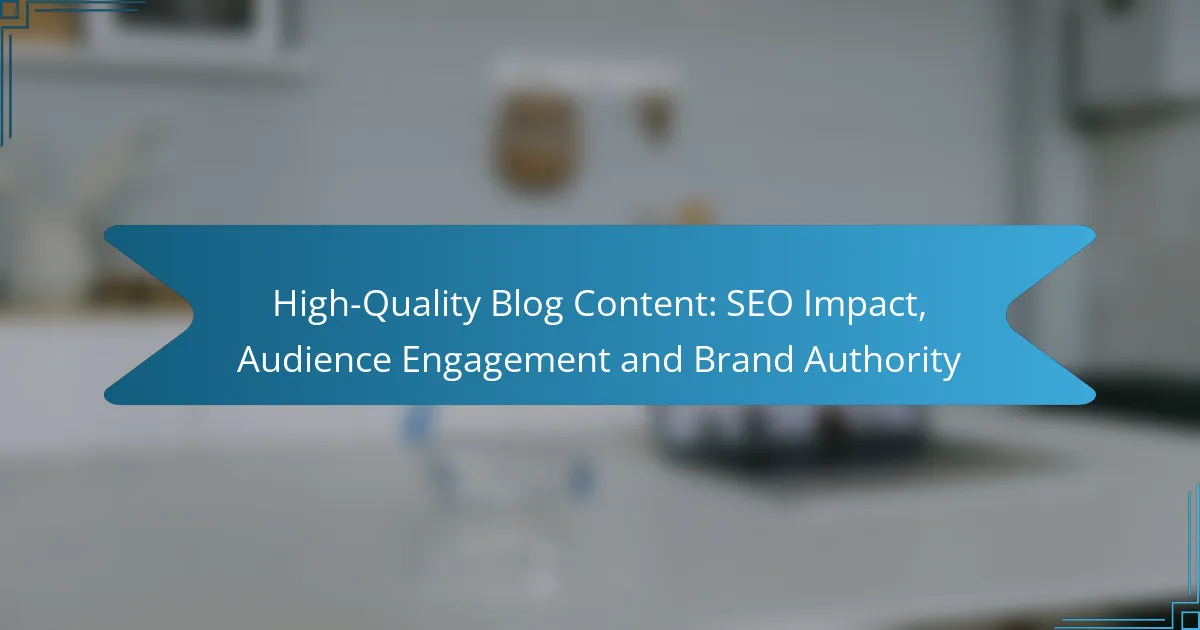High-quality blog content is essential for enhancing SEO, as it boosts visibility on search engines and attracts more visitors. By meeting user intent and engaging the audience, brands can foster deeper connections and establish authority in their industry. Consistently producing valuable content not only improves rankings but also builds trust and encourages audience participation.

How Does High-Quality Blog Content Impact SEO?
High-quality blog content significantly enhances SEO by improving visibility on search engines, attracting more visitors, and increasing engagement. This content meets user intent, which search engines prioritize, leading to better rankings and more organic traffic.
Improves search engine rankings
High-quality blog content boosts search engine rankings by providing valuable, relevant information that aligns with user queries. Search engines like Google use algorithms that favor well-researched, well-written articles, which often results in higher placement on results pages.
To improve your rankings, focus on creating in-depth content that answers common questions in your niche. Regularly updating your blog with fresh, relevant posts can also signal to search engines that your site is active and authoritative.
Increases organic traffic
Producing high-quality blog content can significantly increase organic traffic as it attracts more visitors through improved search rankings. Engaging articles that resonate with your audience encourage sharing, which further amplifies reach.
To maximize organic traffic, incorporate relevant keywords naturally throughout your content. Aim for a balance between keyword optimization and readability to ensure that your articles appeal to both search engines and human readers.
Enhances keyword relevance
High-quality blog content enhances keyword relevance by providing comprehensive coverage of topics that matter to your audience. This relevance helps search engines understand the context of your content, improving the chances of appearing in relevant search queries.
Consider using long-tail keywords that reflect specific user intents. Tools like Google Keyword Planner can help identify these keywords, allowing you to tailor your content accordingly and improve its relevance in search results.

What Are Effective Strategies for Audience Engagement?
Effective strategies for audience engagement focus on creating meaningful interactions that resonate with your target audience. By employing various techniques, you can foster a deeper connection, increase retention, and encourage participation.
Utilizing storytelling techniques
Storytelling techniques can captivate your audience by presenting information in a relatable and memorable way. Use narratives that reflect your brand’s values and connect emotionally with your audience. For example, share customer success stories or behind-the-scenes insights that illustrate your brand’s journey.
To enhance engagement, structure your stories with a clear beginning, middle, and end. This approach not only keeps readers interested but also helps them remember key messages. Aim for authenticity in your storytelling to build trust and credibility.
Incorporating multimedia elements
Incorporating multimedia elements like images, videos, and infographics can significantly boost audience engagement. Visual content tends to capture attention more effectively than text alone, making it easier for users to digest information. For instance, a short video can convey complex ideas quickly and engagingly.
When using multimedia, ensure that it complements your written content rather than distracts from it. Optimize images and videos for fast loading times to prevent user frustration. Consider using a mix of formats to cater to different audience preferences, such as tutorials, interviews, or interactive quizzes.
Encouraging user-generated content
Encouraging user-generated content (UGC) can enhance audience engagement by fostering a sense of community and belonging. Invite your audience to share their experiences, opinions, or creative works related to your brand. This not only provides fresh content but also builds loyalty among your customers.
To facilitate UGC, create campaigns or contests that incentivize participation, such as giveaways or features on your website. Make it easy for users to submit their content through social media hashtags or dedicated submission forms. Always acknowledge and showcase their contributions to strengthen the relationship.

How Can High-Quality Content Build Brand Authority?
High-quality content establishes brand authority by demonstrating expertise, fostering trust, and encouraging audience engagement. When brands consistently produce valuable and informative content, they position themselves as leaders in their industry.
Establishing thought leadership
Creating high-quality content allows brands to showcase their knowledge and insights, positioning them as thought leaders. This can be achieved through in-depth articles, expert interviews, and case studies that address industry challenges and trends.
For example, a tech company might publish white papers on emerging technologies, which not only inform their audience but also highlight their expertise. Regularly sharing innovative ideas can help maintain this leadership status.
Enhancing trust and credibility
Trust and credibility are built through consistent, accurate, and transparent content. High-quality articles that provide valuable information without exaggeration or misleading claims help establish a reliable brand image.
Brands should ensure their content is well-researched and backed by credible sources. Including testimonials and user-generated content can further enhance trust, as potential customers see real experiences from others.
Creating shareable content
High-quality content is more likely to be shared across social media platforms, increasing brand visibility and authority. Engaging formats such as infographics, videos, and interactive content can encourage sharing among users.
To maximize shareability, brands should create content that resonates with their target audience’s interests and needs. Incorporating clear calls-to-action and easy sharing options can further enhance the likelihood of content being shared.

What Are the Key Metrics to Measure Content Success?
Key metrics to measure content success include engagement rates, conversion rates, and bounce rates. These indicators provide insights into how well your content resonates with your audience and its effectiveness in achieving business goals.
Analyzing engagement rates
Engagement rates reflect how actively users interact with your content. This includes metrics like likes, shares, comments, and time spent on the page. High engagement indicates that your content is resonating with readers, while low engagement may suggest a need for improvement.
To analyze engagement, consider using tools like Google Analytics or social media insights. Aim for engagement rates above 1-2% for social media and monitor average time on page, targeting at least 2-3 minutes for blog posts.
Tracking conversion rates
Conversion rates measure the percentage of visitors who complete a desired action, such as signing up for a newsletter or making a purchase. A higher conversion rate indicates that your content effectively guides users toward taking action.
To improve conversion rates, ensure your calls to action (CTAs) are clear and compelling. Test different placements and wording to see what resonates best with your audience. A typical conversion rate for content-driven sites ranges from 1-5%.
Monitoring bounce rates
Bounce rates indicate the percentage of visitors who leave your site after viewing only one page. A high bounce rate may signal that your content is not engaging enough or that users are not finding what they expected.
To lower bounce rates, focus on improving content relevance and user experience. Ensure that your headlines accurately reflect the content and consider adding internal links to keep users exploring your site. Aim for a bounce rate below 40% for optimal performance.

What Are the Prerequisites for Creating High-Quality Blog Content?
Creating high-quality blog content requires a clear understanding of your audience, effective keyword research, and well-defined content goals. These elements ensure that your content resonates with readers and performs well in search engines.
Understanding target audience
Identifying your target audience is crucial for crafting relevant blog content. Consider demographics such as age, location, interests, and pain points to tailor your writing effectively. For example, a blog aimed at young professionals may focus on career development tips, while one for retirees might cover health and leisure activities.
Utilize tools like Google Analytics and social media insights to gather data about your audience. This information can guide your content strategy and help you create posts that engage and inform your readers.
Conducting keyword research
Keyword research is essential for optimizing your blog content for search engines. Start by identifying relevant keywords and phrases that your audience is likely to search for. Tools like Google Keyword Planner or SEMrush can help you find popular terms and assess their competition.
Focus on a mix of short-tail and long-tail keywords to capture a broader audience. For instance, while “digital marketing” is a broad term, “digital marketing strategies for small businesses” targets a specific niche and can drive more qualified traffic.
Defining content goals
Establishing clear content goals helps guide your writing and measure success. Determine what you want to achieve with each blog post, whether it’s increasing website traffic, generating leads, or enhancing brand awareness. Setting specific, measurable goals will help you stay focused and evaluate your performance.
Consider using the SMART criteria—Specific, Measurable, Achievable, Relevant, and Time-bound—to define your objectives. For example, a goal could be to increase organic traffic by 20% over the next three months through targeted blog posts.

How to Optimize Blog Content for SEO?
To optimize blog content for SEO, focus on relevant keywords, quality writing, and user experience. Effective SEO techniques enhance visibility in search engine results, driving more organic traffic to your blog.
Implementing on-page SEO techniques
On-page SEO techniques involve optimizing individual web pages to rank higher and earn more relevant traffic. Key elements include using targeted keywords in titles, headings, and throughout the content, while ensuring the text remains natural and engaging.
Additionally, consider optimizing meta descriptions and image alt texts. These elements not only improve SEO but also enhance user experience by providing clear information about the content.
Utilizing internal and external links
Internal links connect your blog posts to each other, helping search engines understand your site structure and keeping readers engaged longer. Aim to link to relevant articles within your blog, using descriptive anchor text for clarity.
External links to reputable sources can enhance your blog’s credibility and provide additional value to readers. Ensure that these links are relevant and lead to authoritative sites, as this can positively impact your SEO performance.
